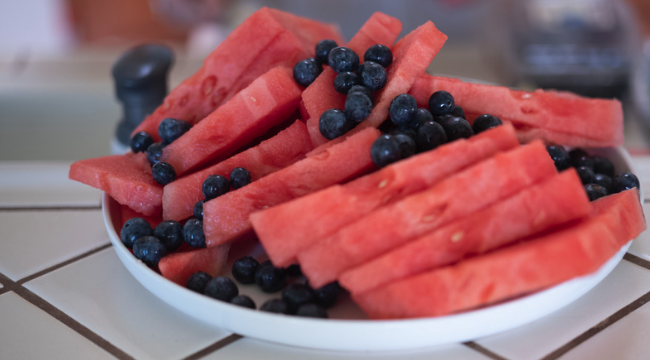It’s a Good Time to Enjoy Watermelon and Blueberries!
go.ncsu.edu/readext?1013095
en Español / em Português
El inglés es el idioma de control de esta página. En la medida en que haya algún conflicto entre la traducción al inglés y la traducción, el inglés prevalece.
Al hacer clic en el enlace de traducción se activa un servicio de traducción gratuito para convertir la página al español. Al igual que con cualquier traducción por Internet, la conversión no es sensible al contexto y puede que no traduzca el texto en su significado original. NC State Extension no garantiza la exactitud del texto traducido. Por favor, tenga en cuenta que algunas aplicaciones y/o servicios pueden no funcionar como se espera cuando se traducen.
Português
Inglês é o idioma de controle desta página. Na medida que haja algum conflito entre o texto original em Inglês e a tradução, o Inglês prevalece.
Ao clicar no link de tradução, um serviço gratuito de tradução será ativado para converter a página para o Português. Como em qualquer tradução pela internet, a conversão não é sensivel ao contexto e pode não ocorrer a tradução para o significado orginal. O serviço de Extensão da Carolina do Norte (NC State Extension) não garante a exatidão do texto traduzido. Por favor, observe que algumas funções ou serviços podem não funcionar como esperado após a tradução.
English
English is the controlling language of this page. To the extent there is any conflict between the English text and the translation, English controls.
Clicking on the translation link activates a free translation service to convert the page to Spanish. As with any Internet translation, the conversion is not context-sensitive and may not translate the text to its original meaning. NC State Extension does not guarantee the accuracy of the translated text. Please note that some applications and/or services may not function as expected when translated.
Collapse ▲Did you know July is National Watermelon AND Blueberry Month? It is, according to the National Watermelon Promotion Board and the US Highbush Blueberry Council. With the hot and dry weather that we’ve experienced over the past several weeks, it’s a good time to find the shade and cool down with one or both of these sweet summer treats!
Here are a few facts and figures we can be proud of about watermelon and blueberry production:
- There are 1140 acres of blueberries grown in Sampson County
- North Carolina ranks 6th in the nation for both watermelons and blueberries
- The United States ranks 7th in watermelon production worldwide
How do you choose the best watermelon?
According to the experts, use the “rule of 3”, which means:
- LOOK – Make sure the watermelon are symmetrical, free of bruises, cuts, and soft spots.
- LIFT – Watermelons are 92% water, so they should be heavy.
- TURN – Look for the “ground spot”, which is the buttery yellow spot on the bottom where it grew in the field.
There is a great video on how to pick a watermelon on Watermelon.org
website, along with lots of great recipes, nutritional facts, and educational information about watermelon. You can also learn more about our North Carolina watermelon industry. Blueberries are Heart-Check certified through the American Heart Association® Heart-Check Food Certification Program. Read more about the heart-health benefits of blueberries.
If you are looking for local markets to find watermelon or blueberries, be sure to use the Visit NC Farms App. We have several farmers markets, local farms and roadside stands on the app where you can find and purchase Sampson County produce! Check out VisitNCFarmsToday for more info on this great app.
Sources of information in this article: Watermelon.org, NCmelons.com; Blueberry.org




